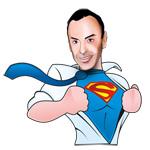Let’s start with the group that should be your greatest number of clients… fat loss. Fat loss clients will end up being 80 to 90% of your clientele. Because of this I suggest that design three different levels of training for fat loss/fitness clients.
Level 1 –Extremely deconditioned client,
-More than 31% body fat (if she is female)
-Little to no gym experience
-Failing most of the functional movement screen.
Level 2 –Average client
-Body fat between 24% and 31%
-Some gym or exercise experience
-Average scores on the functional movement screen
-Has some confidence in their abilities
Level 3 –Highly motivated client
-Wanting to get rid of the last few pounds or just a few body fat percentage points
-Has a specific event they want to train or look good for
-Can pass the functional movement screen with average to excellent scores
-Has a lot of confidence and wants to be challenged
Most of your clients will begin in Level 1 or Level 2, so let’s write the workouts for the Level 2 client. You can then easily put in regressions for the Level 1 client after you’re done. Your Level 2 client is also the one you want to experiment with, not your beginner clients (you don’t want to hurt them or scare them away from working out)
 On to the next question…and this is a personal answer for you and your gym, “What is your philosophy for the fat loss exercise system ?”
On to the next question…and this is a personal answer for you and your gym, “What is your philosophy for the fat loss exercise system ?”
In order to write an overall program, you have to have an exercise philosophy. What do you do with a client that’s going to train with you for 12 and 18 weeks minimum? Do you do the same type of workouts all the time? Do you do boot camp style workouts all the time with your clients? Do you do strength training only and manage their nutrition? Do you do supersets, triplexes, and quad sets? Do you vary tempo? Do you have recovery phases? How do you train your clients properly and professionally?
Once you have these questions answered, you need to plan out your exercise system. I have included a sample image of a training cycle that lasts 18 weeks.
 You can see that this training cycle has 2 major exercise concepts. These can be things such as heavy weights or other training modalities for Theory 1 Mini-Cycle, and boot camps or anaerobic workouts for Theory 2 Mini-Cycle.
You can see that this training cycle has 2 major exercise concepts. These can be things such as heavy weights or other training modalities for Theory 1 Mini-Cycle, and boot camps or anaerobic workouts for Theory 2 Mini-Cycle.
I’ve broken down each of the mini-cycles into a two or three week micro-cycle. This allows clients to do the same type of workout for 2 to 3 weeks, and then switch to a similar type of work out using a different training modality or approach. I could change tempos between the micro cycles, reps and sets, rest periods, the type of equipment I use, or anything else that allows me to train within the same concept, but still makes changes so the client doesn’t get bored, yet still reaches the goal of the Mini-Cycle.
 Even if the client might not need this amount of programming for physical change, it fights boredom while allowing them to see progress physically and mentally. It also keeps the trainer from getting bored or having a lack of direction with the workouts.
Even if the client might not need this amount of programming for physical change, it fights boredom while allowing them to see progress physically and mentally. It also keeps the trainer from getting bored or having a lack of direction with the workouts.
Once you have your overall 12 to 18 week plan done, your Mini-Cycles planned, and your micro-cycles or phases planned, you can start writing out your workouts for each Phase. You should only write out workouts that you’ll do with your clients each week. I suggest writing out two workouts per week. This gives you the appropriate number workouts for the average amount a client will train. It’s also easy to adjust this up or down depending on your client’s training schedule.
Don’t forget to type up your workouts and make a set of training logs. This can be a bunch of three ring binders or you can take the logs to a print center and have them print and bind them. Either way you have a permanent record of your client’s workouts and their progress.
 These logs are a valuable tool for assessing your clients. Evaluate what you are getting done and what you are accomplishing along the way. Put notes in each training log as to what your client can complete, what they enjoy, and the results they are getting. Once the training log is finished, go back and look at the notes from three or four of the training logs of different clients, combine these notes and use them to improve your next set.
These logs are a valuable tool for assessing your clients. Evaluate what you are getting done and what you are accomplishing along the way. Put notes in each training log as to what your client can complete, what they enjoy, and the results they are getting. Once the training log is finished, go back and look at the notes from three or four of the training logs of different clients, combine these notes and use them to improve your next set.
Any time during your evaluation of your Level 2 workouts, you can start developing your Level 1. Based on what you learn from your Level 2 clients, you will have a better idea of what type of training a beginner or deconditioned client needs to go through to get results without getting injured or frustrated.
You will see that your level I clients need to gain confidence and improve mobility before you work them out too intensely. These clients need more support from a coaching and nutrition aspect than a Level 2 or Level 3 client, so write your workouts accordingly.
The initial work might seem a bit time consuming, but you’re building a system you’ll use for the next 2 – 10 years. In addition, you’re reducing your stress, reducing your workload, improving your professionalism, and creating a PROVEN system for fat loss. This is a great marketing tool!
After you’ve got Level 1 and Level 2 workouts created, go out and market yourself as the fat loss expert at your gym or in your area. You can use your workouts and the measurements you take along the way to prove you’re an expert and that your system is what potential clients need to get results.
 This is how you get new clients and tons of referrals. By getting results for your clients and earning their respect as a professional. You will focus more on the client during the session because workout is already created and you’re just fine-tuning it based on the client’s needs that day and other circumstances surrounding the workout. It’s easier to make small changes to a workout than come up with one from scratch once the training session has already begun. Your client can tell the difference.
This is how you get new clients and tons of referrals. By getting results for your clients and earning their respect as a professional. You will focus more on the client during the session because workout is already created and you’re just fine-tuning it based on the client’s needs that day and other circumstances surrounding the workout. It’s easier to make small changes to a workout than come up with one from scratch once the training session has already begun. Your client can tell the difference.
This is definitely enough information to get you going and to help you begin developing your own exercise system that makes you and your clients happy. Now, you can see why it’s important to come up with an exercise system to help you look and be more professional.
Thanks for your time. I know this was a long read, but it’s going to help you take action and build your business to be a success.
-Nick Osborne
